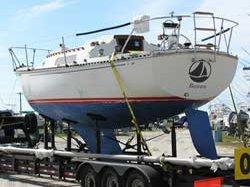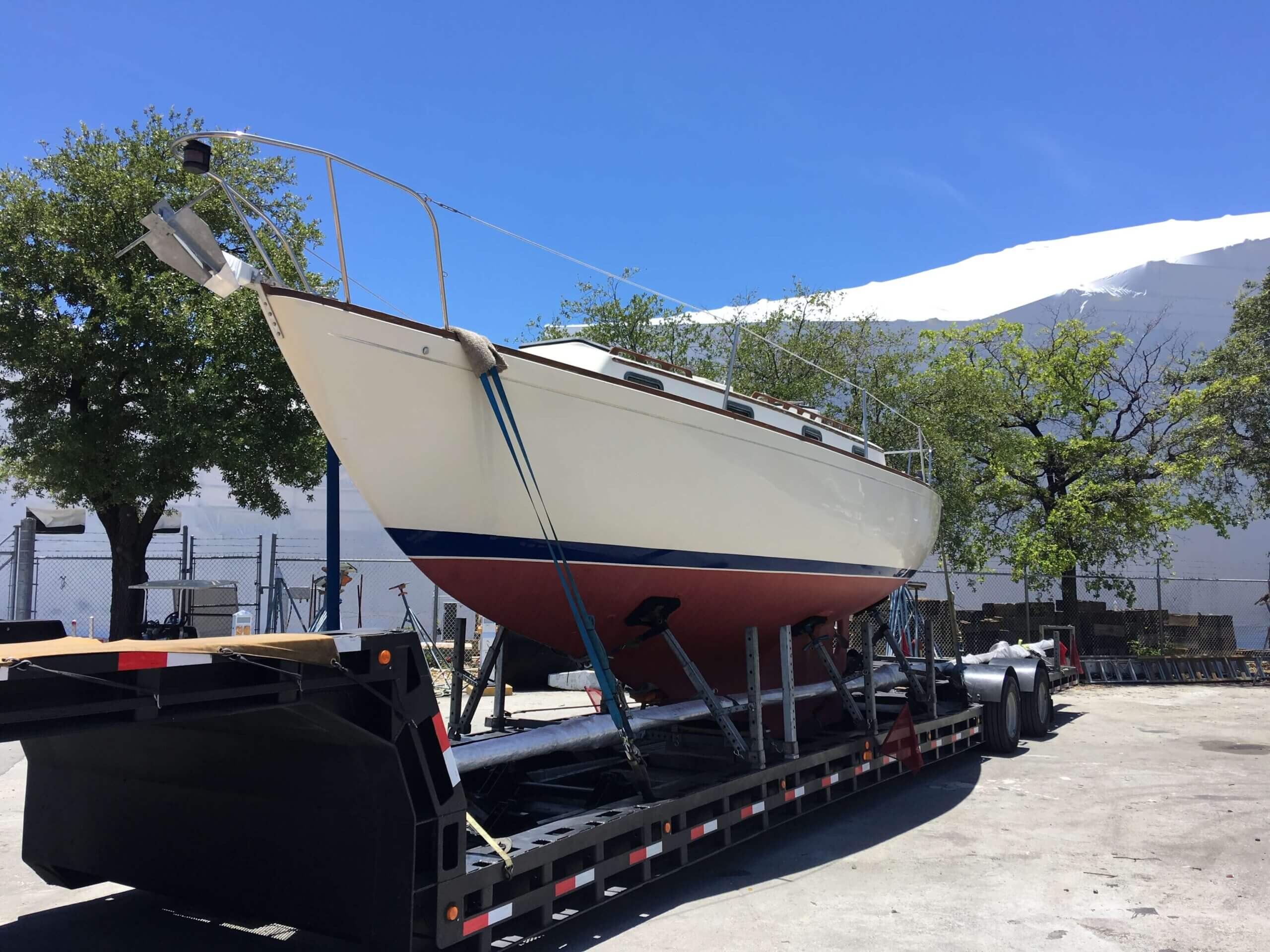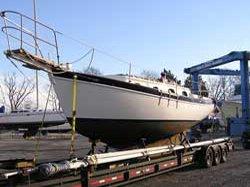Sailboat Transport Preparation Guide
When considering a Sailboat Transportation project there are some areas that are unique to these boats that need to be addressed that are not covered in our other guides. If you have not viewed our Powerboat Transport Guide or our Boat Transport Guide there is additional information contained in those.
Sailboat Rigging Considerations When Transporting Properly

Only seasoned boat haulers should work with sailboat shipping. Loading a sailboat takes time. The setup of the steel work to cradle the boat is done after the travel lift or crane sets the boats to keel on the transport trailer’s keel pad. Your driver will be working under your suspended vessel to cradle the boat and secure the boat and cradle to the transport trailer for it to move on the highway safely and securely to its destination. First, the sailboat mast needs to be removed and partially disassembled, properly resting in its cradle. It is best to disassemble one piece at a time, coil it, and mark where it came from, which makes it easier and quicker when reassembling it. You need to remove the spreaders and store them below, and you need to bring the halyards uptight and coil them at the mast’s base. All winches, etc. and electronic antennas need to be removed as they are delicate and do not travel well. To keep your mast, winches, and sheaves clean and dirt free, wrap them in cellophane like a candy cane. Anchors in a bow roller need to be removed and stowed, as just securing it is not good enough. When getting ready for a sailboat transport unfortunately there is additional work that needs to be done after your boat is hauled out, compared to a powerboat. All lights, winches, wind indicators, and rigging must be removed from the mast and carpet provided for the mast’s tie down points, although you should expect chafing at these points, and if the mast is painted, it is nearly impossible to prevent the paint from chafing. The sailboat haulers nor the sailboat shipping company will not repaint, or pay to repaint the masts if this occurs. Please, do not secure your mast to your boat, as the transport trailers provide a space for the mast.
Height Issues When Transporting Sailboats
 On most sailboats height is not an issue until the boat gets up in the 40’ range. There is deck gear that presents problems that are unique to sailboats. Stanchions, winches, bow and stern pulpits, even the helm sometimes sticks up a great deal. Every effort should be made to reduce the height as much as possible in sailboats that the overall loaded height exceeds 13’6” if at all possible. This may not be possible is cases where deck winches or other gear is bedded in really tough or fasteners are not readily accessible for removal. Transporting Sailboats at times can be trying, but with a little effort, issues related to height can be avoided. Sailboats that are over height on the transport trailer may need a pole car and this increases the cost of the sailboat transport. If the move is a short one, under 400 hundred miles most of the time it is more cost effective to transport the sailboat with a pole car over height, than it is to go through the effort of removing stubborn deck gear. It needs to be said here that using the proper equipment is critical when moving boats of all kinds. When height is a problem the correct trailer designed for sailboats and an experienced driver to transport oversize boats assisting the loader can save you the customer a great deal of money. A Sailboat transportation company or sailboat shipping company usually does not carry tools adequate to prep your sailboat in this manner.
On most sailboats height is not an issue until the boat gets up in the 40’ range. There is deck gear that presents problems that are unique to sailboats. Stanchions, winches, bow and stern pulpits, even the helm sometimes sticks up a great deal. Every effort should be made to reduce the height as much as possible in sailboats that the overall loaded height exceeds 13’6” if at all possible. This may not be possible is cases where deck winches or other gear is bedded in really tough or fasteners are not readily accessible for removal. Transporting Sailboats at times can be trying, but with a little effort, issues related to height can be avoided. Sailboats that are over height on the transport trailer may need a pole car and this increases the cost of the sailboat transport. If the move is a short one, under 400 hundred miles most of the time it is more cost effective to transport the sailboat with a pole car over height, than it is to go through the effort of removing stubborn deck gear. It needs to be said here that using the proper equipment is critical when moving boats of all kinds. When height is a problem the correct trailer designed for sailboats and an experienced driver to transport oversize boats assisting the loader can save you the customer a great deal of money. A Sailboat transportation company or sailboat shipping company usually does not carry tools adequate to prep your sailboat in this manner.
Our Transporters Are Experts at Transporting Sailboats

Interior items, floating free, need to be secured properly and stowed to prevent damage.
Remember, ask your sailboat transport company if your driver has experience with moving sailboats! Sailboat haulers and the sailboat transport company need knowledgeable of sailboat shipping. I hope that we have answered all your questions. Feel free to print this out and give it to the boatyard who will be preparing for your sailboat transportation. Don’t hesitate to give us a call if we can answer any question regarding transporting your sailboat. Sailboat haulers and a sailboat transport company need to be knowledgeable of Sailboat shipping.
